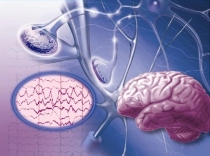
Electrical discharge of nerve cells out of control
NGFN scientists find gene defect which can trigger epilepsy

Epileptic seizures triggered by simultaneous electrical discharges of nerve cells.
In the EEG (left) these discharges can be visualized.
In the EEG (left) these discharges can be visualized.
The research teams of Assistant Professor Armin Heils (Bonn) and Professor Holger Lerche (Ulm), in cooperation with Assistant Professor Klaus Krampfl (Hannover), have long been searching for genes that cause epilepsies. Their primary research focus has been on GABA receptors, which are widespread in the brain and spinal cord and regulate movement and sleep, among other things. The GABA receptor is located in the membrane of nerve cells and serves as docking station for certain messenger substances. If a certain signal substance binds to a GABA receptor, a mechanism is triggered which inhibits the electrical discharge of nerve cells. “This control mechanism is rendered dysfunctional by the identified gene variant. The nerve cells become uninhibited, that is to say overexcited, and an epileptic seizure can occur,” Armin Heils explains.
A lot speaks for the hypothesis that the loss of this negative control could be a central mechanism for the occurrence of epilepsies. Already three years ago NGFN scientists identified a defect in an ion channel as the genetic cause of several forms of epilepsy. This ion channel is significantly involved in the inhibition of nerve cells by means of the GABA receptor. Despite these achievements, much is still left for the epilepsy researchers to discover. “We are just beginning to elucidate the genetic causes; up to now, we have found mutations only in rare cases. Scientific studies show that a great many gene loci play a role in the development of this disease. We have found the mutation in the gene of the GABA receptor in only one of hundred epilepsy patients as trigger of the disease,” Holger Lerche explains. “That is why it is important to trace still unknown variants of the epilepsy disease genes,” Armin Heils adds. “Only when we know which genetic defects are responsible for a certain form of epilepsy will it perhaps one day be possible to help epilepsy patients with a personalized therapy.”




